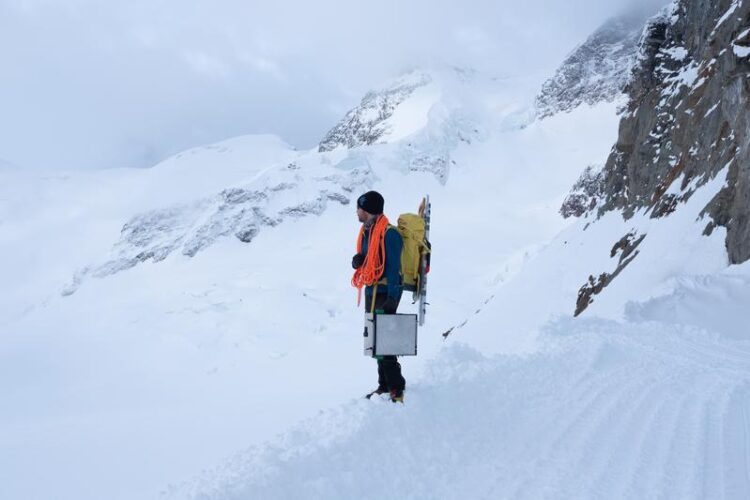Research on a rope

With rope, saw and case: Lars Mewes, snow physicist at the SLF, on his way to work at the Jungfraujoch.
(c) Lars Mewes, SLF ( CC-BY)
SLF physicist Lars Mewes is investigating snow crystals’ direction of growth and analysing snow profiles on the Jungfraufirn Glacier. His work is part of a collaboration with other institutions, which the SLF was invited to join because of its expertise on snow.
Thin air, peak temperatures of around -10 °C – SLF snow physicist Lars Mewes has swapped his cosy office in Davos for a workplace of extremes this week. Since Monday, he has been at the high-altitude research station on the Jungfraujoch, at an elevation of over 3,400 metres. From there, he sets off daily on skis to the Jungfraufirn, 200 metres below, to take measurements and snow samples for the cold laboratory in Davos. “As a snow expert, I’m supporting a project run by the German Aerospace Center (DLR) and ETH Zurich,” explains the scientist. The research institutions called in the SLF specifically because of its expertise in this area.
Measuring structures
The ETH Zurich researchers have installed a ground-based radar on the Jungfraujoch, which they are using to measure the amounts of new snow as well as the structure of firn and of the entire glacier. Mewes digs snow profiles directly on the glacier and then analyses them. “Thanks to our SnowImager, a device for determining snowpack structure, we’re able to achieve a very fine resolution, in the millimetre range,” says the physicist. The ETH Zurich researchers then compare his findings with the results of their radar images. This enables them to identify how well their method is already working – and where they may need to make improvements.
Mewes’ work is not without its risks. While on the glacier, the researchers secure each other by a rope in case a crevasse opens up. And the thin air makes itself felt on the return journey to the station, which involves climbing several hundred metres in altitude on touring skis, while carrying a lot of baggage. He will return to Davos at the end of the week.
Closer to reality
In late March, the DLR aircraft will circle over the Jungfraujoch and the Aletsch Glacier, weather permitting. SLF researchers will then return to the site, among other things to investigate the anisotropy of snow crystals (see box) in new snow. “We’re taking a reference measurement here to determine the direction in which the ice crystals are orientated,” explains Mewes. This will then be used by the DLR researchers, as they will be measuring the snowpack from the plane using radar. So far, they have only compared theoretical values from the scientific literature with their data. The SLF’s work should help yield results that are closer to reality.
What is… anisotropy?
Properties and processes that have a direction but differ according to the direction of measurement are called anisotropic. The growth and formation of crystals is an anisotropic process, as is the propagation of a laser beam. The opposite are isotropic processes, such as light rays from the sun, which, unlike laser beams, spread out evenly in all directions.
Wissenschaftliche Ansprechpartner:
Dr. Lars Mewes, phone +41 81 417 01 53, lars.mewes@slf.ch
Media Contact
All latest news from the category: Earth Sciences
Earth Sciences (also referred to as Geosciences), which deals with basic issues surrounding our planet, plays a vital role in the area of energy and raw materials supply.
Earth Sciences comprises subjects such as geology, geography, geological informatics, paleontology, mineralogy, petrography, crystallography, geophysics, geodesy, glaciology, cartography, photogrammetry, meteorology and seismology, early-warning systems, earthquake research and polar research.
Newest articles

Innovative 3D printed scaffolds offer new hope for bone healing
Researchers at the Institute for Bioengineering of Catalonia have developed novel 3D printed PLA-CaP scaffolds that promote blood vessel formation, ensuring better healing and regeneration of bone tissue. Bone is…

The surprising role of gut infection in Alzheimer’s disease
ASU- and Banner Alzheimer’s Institute-led study implicates link between a common virus and the disease, which travels from the gut to the brain and may be a target for antiviral…

Molecular gardening: New enzymes discovered for protein modification pruning
How deubiquitinases USP53 and USP54 cleave long polyubiquitin chains and how the former is linked to liver disease in children. Deubiquitinases (DUBs) are enzymes used by cells to trim protein…



